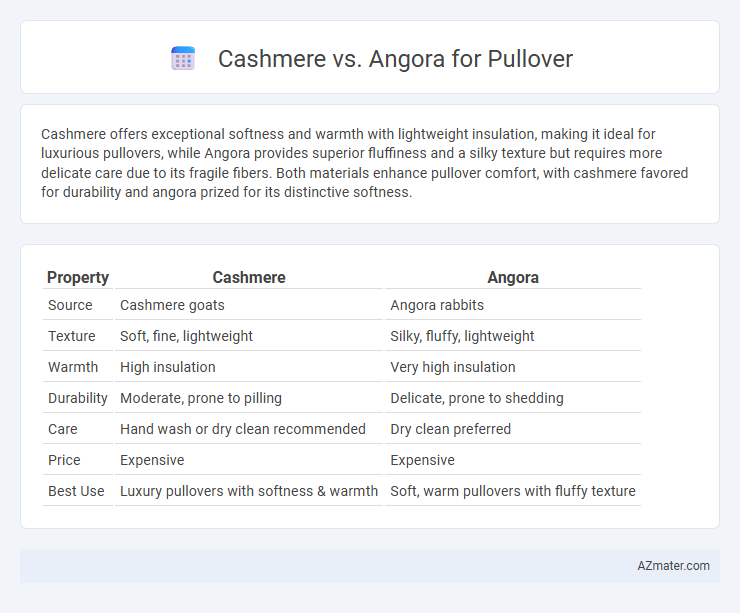Cashmere offers exceptional softness and warmth with lightweight insulation, making it ideal for luxurious pullovers, while Angora provides superior fluffiness and a silky texture but requires more delicate care due to its fragile fibers. Both materials enhance pullover comfort, with cashmere favored for durability and angora prized for its distinctive softness.
Table of Comparison
| Property | Cashmere | Angora |
|---|---|---|
| Source | Cashmere goats | Angora rabbits |
| Texture | Soft, fine, lightweight | Silky, fluffy, lightweight |
| Warmth | High insulation | Very high insulation |
| Durability | Moderate, prone to pilling | Delicate, prone to shedding |
| Care | Hand wash or dry clean recommended | Dry clean preferred |
| Price | Expensive | Expensive |
| Best Use | Luxury pullovers with softness & warmth | Soft, warm pullovers with fluffy texture |
Introduction: Understanding Cashmere and Angora
Cashmere and Angora are two luxurious fibers commonly used in high-end pullovers, each derived from distinct animals--Cashmere from the undercoat of Cashmere goats and Angora from Angora rabbits. Cashmere is prized for its softness, warmth, and durability, offering lightweight insulation ideal for colder climates. Angora, known for its exceptional fluffiness and silky texture, provides superior warmth but requires delicate care to maintain its plush appearance and longevity.
Origin and Production Processes
Cashmere originates from the undercoat of Cashmere goats primarily found in Mongolia, China, and Kashmir, where fibers are collected through combing during molting season. Angora comes from the Angora rabbit, mostly raised in France, Turkey, and China, with fibers harvested by gentle plucking or shearing every few months. Both fibers undergo meticulous cleaning and dehairing processes to ensure softness and durability in luxury pullovers.
Fiber Characteristics: Softness and Texture
Cashmere fibers are finer and softer, measuring 14-19 microns in diameter, resulting in a smooth and luxurious texture ideal for delicate pullovers. Angora fibers, derived from Angora rabbits, are known for their exceptional softness combined with a fluffy, lightweight feel due to fiber diameters of about 12-16 microns and a hollow core. The unique fiber structure in Angora creates a silky halo effect, while Cashmere offers a denser and more resilient fabric surface for long-lasting softness.
Warmth and Insulation Properties
Cashmere pullovers offer exceptional warmth due to their fine fibers which trap heat efficiently, providing superior insulation in cold weather. Angora, derived from rabbit fur, is known for its lightness and softness but tends to be less insulating than cashmere, as it allows more air permeability. Choosing cashmere ensures better heat retention while angora excels in lightweight warmth with a softer feel.
Durability and Longevity
Cashmere pullovers are renowned for their softness but have moderate durability, often requiring delicate care to maintain longevity. Angora sweaters offer exceptional warmth and a fluffy texture but tend to be less durable due to the fragile angora fibers that can shed or pill over time. Choosing cashmere ensures a longer-lasting garment with proper maintenance, while angora provides luxury and softness at the cost of a shorter lifespan.
Care and Maintenance Requirements
Cashmere pullovers require gentle hand washing with mild detergent or dry cleaning to preserve softness and prevent fiber damage, while avoiding excessive heat or agitation. Angora sweaters demand even more delicate care, ideally dry cleaning, as their fine fibers are prone to matting and shedding; hand washing in cold water and air drying flat is necessary to maintain shape and texture. Both materials should be stored away from direct sunlight and humidity, with moth repellents used to prevent damage during long-term storage.
Price Comparison and Value
Cashmere pullovers typically command higher prices due to the labor-intensive process of harvesting fine undercoat fibers from cashmere goats, while Angora garments, derived from the softer mohair of Angora rabbits, are generally more affordable yet still luxurious. The value of cashmere lies in its exceptional warmth, softness, and durability, often justifying the premium cost for long-term use. Angora offers excellent insulation and a distinctive fluffy texture but may require more delicate care, impacting its overall value compared to cashmere.
Ethical and Environmental Considerations
Cashmere and Angora pullovers differ significantly in ethical and environmental impact, with cashmere production often criticized for overgrazing by goats, leading to desertification, while Angora wool raises concerns due to animal welfare issues like hair-pulling from rabbits. Sustainable cashmere initiatives focus on land management and supporting pastoral communities to reduce environmental degradation, whereas ethical Angora production emphasizes cruelty-free harvesting methods such as combing instead of plucking. Consumers seeking eco-friendly and ethical pullovers should prioritize certifications like the Sustainable Fibre Alliance for cashmere and the Responsible Wool Standard or animal welfare assurances for Angora products.
Style and Versatility for Pullovers
Cashmere pullovers offer a luxurious, smooth texture with a natural sheen, making them ideal for elegant, refined styles suitable for both casual and formal occasions. Angora pullovers provide a soft, fluffy appearance with a distinctive halo effect, lending a cozy, vintage-inspired aesthetic perfect for relaxed, stylish layering. Both fibers excel in versatility, with cashmere's sleek drape enhancing tailored looks and angora's warmth and volume adding unique dimension to casual wear.
Choosing the Right Fabric for Your Needs
Cashmere offers exceptional softness and warmth, making it ideal for luxurious, lightweight pullovers suited to cold weather. Angora, derived from rabbit hair, provides a fluffy texture with superior insulation but requires careful maintenance due to its delicate fibers. When choosing between cashmere and angora, consider factors like warmth, softness, durability, and care requirements to ensure the pullover meets your comfort and lifestyle needs.

Infographic: Cashmere vs Angora for Pullover
 azmater.com
azmater.com